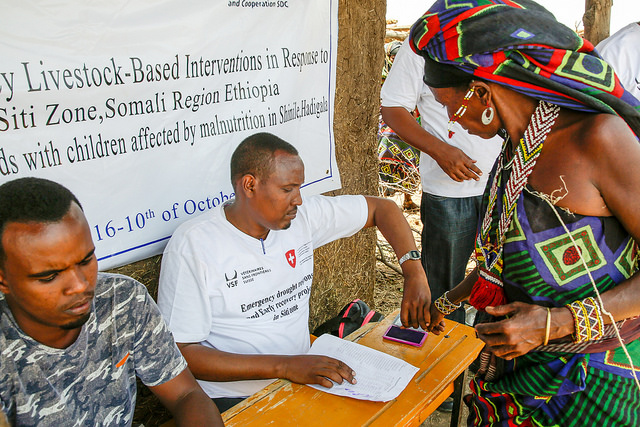In situation of droughts, floodings and other climatic catastrophes, as wells as during conflicts and civil wars that force people to displace, the mission of VSF International is to provide the affected populations with the means and ability to continue production, so that they can feed themselves and ensure that their most vital economic needs are met.
Livestock is a key asset that offers multiple benefits (providing food and income, draft power, manure, social status, economic security and political power). As a result, the loss of livestock due to natural or man-made disasters is multi-dimensional. It has a severe impact upon the livelihoods of people dependent on them, and also upon the different actors who depend on the livestock economy and its value chains.
In the developing world, there is also a significant gender element to livestock production. Small livestock are among the few assets that women in smallholder families own and control, and in many instances women also provide much of the labour, and may control some of the income from the larger animals that they do not own, such as milk cattle. If the importance of livestock to women is not clearly understood when emergency interventions occur, women and children are likely to suffer disproportionately.
As part of our emergency response, we follow the Livestock Emergency Guidelines and Standards (LEGS), which offer guidance and a set of operational principles on the main types of interventions targeting livestock in emergency contexts. LEGS covers interventions in six main categories: provision of feed, provision of water, provision of veterinary services, destocking, restocking, and livestock shelter and settlement interventions.
We support communities affected by disasters and improve their resilience capacity through:
- Combatting malnutrition, primarily in women and children, through the valorisation of local resources and especially animal-sourced food (dried meat, milk, blood)
- Supplying feed to preserve key livestock assets such as milking animals and the core breeding stock (feed distribution or sales at reduced price, or establishment of community-owned feed banks)
- Improving water availability through the rehabilitation or construction of water points, boreholes or water catchments, but also food-for-work or cash-
for work schemes for water-source rehabilitation efforts. In some extreme
situations, when there is urgent need and no other cost-effective options available, water may be delivered by truck. - Providing animal health services through livestock vaccination and de-worming campaigns, training of Community-based Animal Health Workers (CAHWs), support to the public and private veterinary services, and provision of good quality drugs and support to the cold chain infrastructure
- Destocking affected animals before they become so weak as to lose their value, die or pose a risk to public health, buying weakened animals from the livestock keepers and paying the villagers for processing the meat which is later distributed as food aid to the most vulnerable households
- Restocking livestock assets through distribution of animals aiming either at replacing livestock that have been lost, or at building livestock assets as a new livelihood activity
-
Construction or rehabilitation and equipment of key infrastructures that allows rebuild the economic activities after disasters.
Read more:



